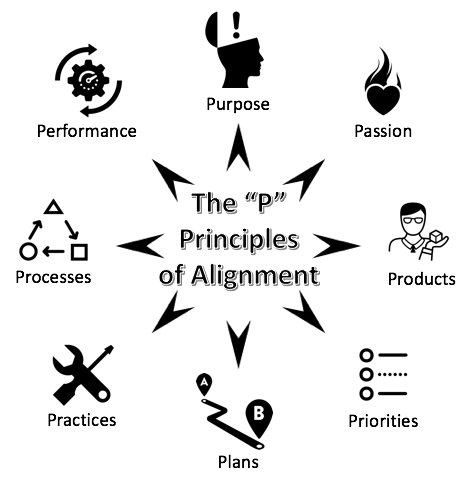 Today I was speaking with a colleague about their experience working with several startups. They agreed that start-ups have “natural alignment”. They also agreed that many startups have major challenges maintaining alignment, as they grow. But why?
Today I was speaking with a colleague about their experience working with several startups. They agreed that start-ups have “natural alignment”. They also agreed that many startups have major challenges maintaining alignment, as they grow. But why?
As I discussed in my last post on this topic, I think about organizational alignment in 8 categories, what I call the “P” Principles of Alignment:

Entrepreneurs and their small, hand-picked teams possess alignment in these areas out of necessity (they have limited time and resources) and due to their degree of focus (they all think about and talk about the same problems and opportunities, every day).
But as the team grows, along with complexity of the business, this becomes exponentially harder. Not everyone is privy to every conversation. Decisions are made by a subset of the team, and no one takes the time to fully explain them to others. Sometimes opportunity (or adversity) trumps purpose, and the team gets pulled into doing things that weren’t part of the original vision or the plan. These (and other) behaviors lead to team members who second guess decisions, who misunderstand objectives, and who lose some of their passion for the work.
If left unchecked, over time, this becomes a slow, predictable slide to organizational misalignment. When investors bet on a startup, they are betting on the organization’s purpose, their product, and their ability to scale to some level. It can be much harder to vet this capability to scale, than it is to vet the value and differentiation of the product. Most VC’s can tell stories of bets made on firms that had the right product at the right time, but that couldn’t “cross the chasm” presented by rapid growth.
Leadership must commit considerable effort to maintaining focus, maximizing communications, and maintaining alignment during periods of growth. What are some things they can do?
- Continuously reinforce the Purpose – What we’re here to accomplish. Ensure every new team member “gets it”.
- Carefully grow the team with people whose Passions are compatible with one another, and with the Purpose of the organization. Foster personal relationships that will carry the team through periods of adversity.
- Don’t lose your commitment to a maniacal understanding of customer needs and preferences. It’s what made your initial Product great. Keep it up.
- Don’t fall into the trap of having many “top priorities”. Be very clear on the One Top Priority of the organization.. and be sure that “supporting priorities” really do support the Top Priority, and don’t distract attention from it.
- Ensure business and project Plans take a holistic view of risks, resource constraints, and what constitutes “success”.
- Develop management Practices that are open, clear, lean and agile. Eschew bureaucracy, but know that increasing clarity is NEVER a waste of time.
- Be sure your Processes enable your Purpose and Priorities. Never become a slave to process, for process’ sake. “Because that’s the way we do things here” is never a great answer.
- Measure what is truly important, celebrate successes, and adapt when necessary. Build a culture of Performance, based on alignment of all the other elements. At the end of the day, it’s NOT all about the paycheck.
Nothing worth having comes easily. But by applying the “P” Principles, you can evaluate risks to organizational alignment, and plan actions to help maintain alignment as you grow.
Question: What are some other ways to maintain alignment during periods of growth? You can leave a comment by clicking here.

Please note: I reserve the right to delete comments that are snarky, offensive or off-topic. By commenting here, you agree that I may use your comments for promotional purposes.